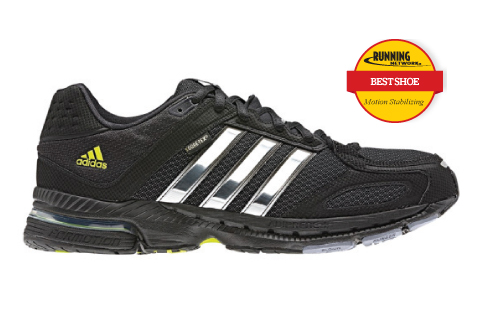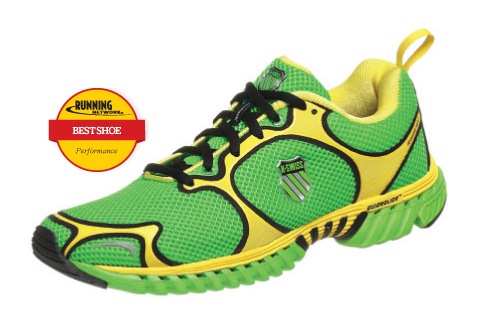2012 Fall Shoe Review

A look across the landscape of running shoes for Fall 2012 reveals more product diversity than in any season of the past decade. The potential for confusion points to the need for education, and we cannot stress this message enough: Runners need to know what their feet are like and get the shoes that meet those needs. This knowledge is not static. Rather, it’s a constantly changing equation where factors such as fitness, injuries, aging, and weight gain/loss, among other things, affect where you are on the running continuum. And you must monitor the role your shoes play in that equation.
Two trends continue, both related to shoe weight. First, 20 percent of the shoes in this Review are new shoes—all of them in the Performance category—so we know that lightweight shoes are readily available Second, more than 85 percent of the updated shoes are both lighter and a bit more expensive than the shoes they replaced. The maxim of the lightweight trend is apparently true: Less is more. That is, less weight costs more. The up-side is that the efforts to lighten these shoes have not compromised performance.
Some of the new shoes follow the path of lower-profile geometry, allowing even more running footwear choices. It has never been more important to know the characteristics of your feet and what footwear choices will work for your current fitness level and your biomechanics. It’s our hope that this Review will help you make great choices!
[Motion Stabilizing]
Adidas Supernova Sequence 5 $115
 Round 5 of the Supernova Sequence features a few changes to a franchise shoe. The upper is breathable with soft, welded microsuede overlays, and synthetic leather at heel and toe. The lacing features a saddle-like design integrated with the logo stripes, but it’s decoupled near the bottom of the lace throat for better forefoot flexion. Adjustments to the last afford a better fit for a wider range of foot shapes. The midsole is the familiar, though reconfigured, adiPrene+, which provides a responsive feel to the forefoot. A slightly larger ForMotion unit in the heel provides a smoother ride, thanks to the heel bevel’s new sculpting. The ProModerator+ component has been dialed in to effectively support the sidewall. The outersole retains the proven Continental® rubber with blown rubber in the forefoot. Its combination of stability, cushioning, and size range earned the Supernova Sequence 5 honors as our Best Shoe in the Motion Stabilizing category.
Round 5 of the Supernova Sequence features a few changes to a franchise shoe. The upper is breathable with soft, welded microsuede overlays, and synthetic leather at heel and toe. The lacing features a saddle-like design integrated with the logo stripes, but it’s decoupled near the bottom of the lace throat for better forefoot flexion. Adjustments to the last afford a better fit for a wider range of foot shapes. The midsole is the familiar, though reconfigured, adiPrene+, which provides a responsive feel to the forefoot. A slightly larger ForMotion unit in the heel provides a smoother ride, thanks to the heel bevel’s new sculpting. The ProModerator+ component has been dialed in to effectively support the sidewall. The outersole retains the proven Continental® rubber with blown rubber in the forefoot. Its combination of stability, cushioning, and size range earned the Supernova Sequence 5 honors as our Best Shoe in the Motion Stabilizing category.
[Performance]
K-Swiss Kwicky Blade Light N $135

The new Kwicky Blade Light N is the neutral version of the Kwicky Blade Light. They’re equals in every way but one: Here the midsole is a single density. The ride is a good blend of cushioning and responsiveness, thanks to the EVA Strobel board, GuideGlide, and midsole foam. The upper is an open stretch mesh for a flexible, seamless feel. A full-welded saddle secures the foot and there’s extra support from the thermoplastic device on the medial half of the saddle. The interior is cushy at the ankle collar, and the Ion Mask treatment keeps the shoe from absorbing extra moisture in all conditions. The outersole is carbon and blown rubber placed effectively only in the high-wear areas, providing durability without compromising flexibility. The mix of lightness, responsiveness, and performance earned the Kwicky Blade Light N a tie as our Best Performance Shoe.
[Performance]
ASICS Gel-Lyte 33 $100
.jpg)
The Gel-Lyte 33 harkens back, if only philosophically, to one of the most popular models in ASICS’ history, the Gel-Lyte. The thin, synthetic mesh upper is supported by welded overlays that provide just enough structure to keep the foot positioned properly. While spare, it doesn’t feel skimpy under the tongue or in the ankle collar. The resilient, single density Solyte midsole flexes well and cushions without hindering motion. The new sidewall sculpting aids in the flexibility. The narrow waist (where the midfoot narrows into the arch) provides lateral support to the fifth metatarsal bone, noticeable but not uncomfortable. The outersole is carbon rubber, but only where needed for durability (nearly half the sole goes without). Its light weight, sleek design, and excellent cushioning were responsible for the Gel-Lyte 33 receiving our award for Best New Shoe.
Other Notable Motion Stabilizing Shoes: Mizuno Wave Alchemy 12—$115; New Balance 870 v2—$110; New Balance 1260 v2—$145;Saucony Progrid Omni 11—$120
[Performance] Saucony ProGrid Kinvara 3 $100

For such a low-profile shoe, the ProGrid Kinvara emerges in Round 3 with a highprofile reputation. The upper is a semi-open mesh supported with Flex-Film welded overlays and a synthetic leather toecap. The textured polyester interior and the foam lobes beneath the ankle have been retained as they effectively reduce weight and improve fit. The midsole features the same heel-to-toe drop (4mm) that’s been responsible for its success. Resculpting has improved the lateral release—the ability of the shoe’s heel to flex to the outside so the foot is discouraged from overpronating—and softened the ride a touch. The outersole is still carbon rubber on the heel and selected forefoot lugs, but it’s been redesigned to feel lightweight while providing a better touchdown. The outstanding ride, fit, and innovative use of new materials earned the ProGrid Kinvara 3 a tie as our Best Performance Shoe.
[Performance]
Puma Faas 350 $85

The Faas 350 is the latest of the Faas shoes, and one of the most versatile. The upper is a closed, though breathable, mesh, and soft sueded overlays help the upper hold its shape but provide little more structure than that. The molding in the sole allows the foot to flex efficiently. Described as a racing shoe, it actually has more "oomph" to it. We say, with its light and highly flexible feel, it’s suitable for tempo runs or some shorter training runs. The midsole is Faas Foam, a very resilient and flexible EVA formulation. The ride is responsive with a good deal of proprioceptive feedback, and it features Puma’s lowest heel-to-toe drop (6 millimeters). The low-profile design makes it stable. The outersole is carbon rubber in the high-wear areas, and toughened and textured foam over the rest of the sole. The combination of lightness, fit, and especially the economical price earned the Faas 350 honors as our Best Value Shoe.
[Performance]
Nike LunarGlide+4 $110
 The LunarGlide series has been a welcome blend of straightforward stability and innovative solutions. Version 4 overhauls both the upper and the chassis, lightening up the shoe in the process. The upper is an engineered mesh—smooth on the interior and designed to maximize evaporation—while providing support where needed. The new lacing system extends the promise of Flywire more effectively, with new Dynamic Flywire strands that wrap the midfoot securely and gather in groups of three at the eyestay, providing continuous adjustment based on foot movement. In the midsole, the carrier foam has been pared down on the lateral sidewall to allow the Lunarlon to absorb shock more effectively, and the bottom of the carrier has been opened for better flexion. The cushioning, light weight, and variable fit earned the LunarGlide+ 4 our Best Renovation award.
The LunarGlide series has been a welcome blend of straightforward stability and innovative solutions. Version 4 overhauls both the upper and the chassis, lightening up the shoe in the process. The upper is an engineered mesh—smooth on the interior and designed to maximize evaporation—while providing support where needed. The new lacing system extends the promise of Flywire more effectively, with new Dynamic Flywire strands that wrap the midfoot securely and gather in groups of three at the eyestay, providing continuous adjustment based on foot movement. In the midsole, the carrier foam has been pared down on the lateral sidewall to allow the Lunarlon to absorb shock more effectively, and the bottom of the carrier has been opened for better flexion. The cushioning, light weight, and variable fit earned the LunarGlide+ 4 our Best Renovation award.
Other Notable Performance Shoes: Adidas adiPure Motion—$110; Adidas adiZero Tempo 5—$110; Mizuno Wave Precision 13—$110
[Neutral]
Nike Air Pegasus+ 29 $100
 T
T
he Pegasus has a legacy that stretches back three decades—easily the longest run in the industry. The new upper is an engineered mesh, alternating open areas for breathability and closed areas for support. Welded supports—both internally and as an external saddle—provide security to the fit, and the eyestay is segmented into three pairs of eyelets, allowing them to flex separately as the foot moves. The midsole is Cushlon, and the crashpad has been removed in favor of a new geometry with sidewall grooving that allows a smooth lateral release and streamlines the transition. The outersole features a well-segmented layer of “environmentally preferred” rubber with waffles medially and a texture of tiny fins on the lateral side that add traction and a tactile feel to the ride. The net effect is a versatile neutral shoe for high-mileage training.
[Neutral]
Brooks Glycerin 10 $140
 The Glycerin is Brooks’ premium neutral shoe, and the 10 focuses on “premium-izing” a few areas. The upper adopts a full rand for support, but in a scaled-back approach that relies on suede straps to provide a softer, but surprisingly tough structure. The midfoot TPU cage allows the lacing to flex where needed while effectively supporting the foot. The mesh is a new design with a more weather-repellent microfiber element. Inside, a foot-conforming layer of foam with a textured surface keeps the foot in place. The midsole cushioning is now a plush blend of responsive performance and cushy protection. The sidewall grooves essentially turn the entire lateral side into an extended crashpad. The outersole has good longitudinal flexibility. The heel clefts are gone, but the keyhole-shaped openings in the pods allow articulation. Its combination of protection, plush comfort, and great cushioning earned the Glycerin our Best Neutral Shoe honors.
The Glycerin is Brooks’ premium neutral shoe, and the 10 focuses on “premium-izing” a few areas. The upper adopts a full rand for support, but in a scaled-back approach that relies on suede straps to provide a softer, but surprisingly tough structure. The midfoot TPU cage allows the lacing to flex where needed while effectively supporting the foot. The mesh is a new design with a more weather-repellent microfiber element. Inside, a foot-conforming layer of foam with a textured surface keeps the foot in place. The midsole cushioning is now a plush blend of responsive performance and cushy protection. The sidewall grooves essentially turn the entire lateral side into an extended crashpad. The outersole has good longitudinal flexibility. The heel clefts are gone, but the keyhole-shaped openings in the pods allow articulation. Its combination of protection, plush comfort, and great cushioning earned the Glycerin our Best Neutral Shoe honors.
Other Notable Neutral Shoes: ASICS Gel-Cumulus 14—$110; ASICS gel-Nimbus 14—$140; Brooks Dyad 7—$110; Brooks ghost 5—$110; Mizuno Wave Enigma 2—$135






